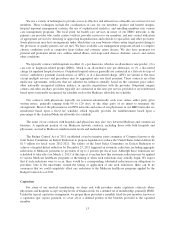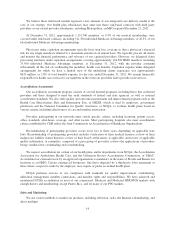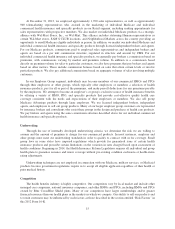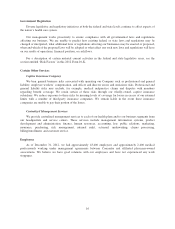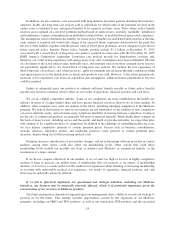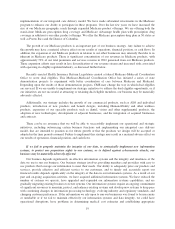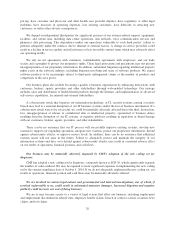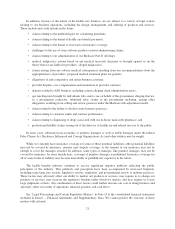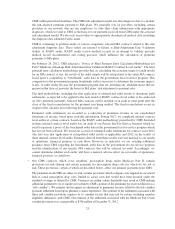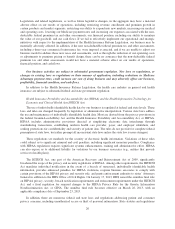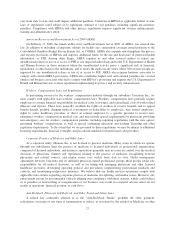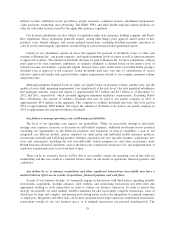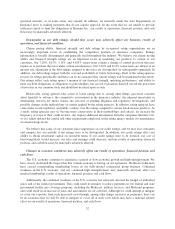Humana 2012 Annual Report Download - page 32
Download and view the complete annual report
Please find page 32 of the 2012 Humana annual report below. You can navigate through the pages in the report by either clicking on the pages listed below, or by using the keyword search tool below to find specific information within the annual report.As a government contractor, we are exposed to risks that may materially adversely affect our business or
our willingness or ability to participate in government health care programs.
A significant portion of our revenues relates to federal and state government health care coverage programs,
including the Medicare, military, and Medicaid programs. These programs accounted for approximately 78% of
our total premiums and services revenue for the year ended December 31, 2012. These programs involve various
risks, as described further below.
• At December 31, 2012, under our contracts with CMS we provided health insurance coverage to
approximately 384,200 Medicare Advantage members in Florida. These contracts accounted for
approximately 15% of our total premiums and services revenue for the year ended December 31, 2012.
The loss of these and other CMS contracts or significant changes in the Medicare program as a result of
legislative or regulatory action, including reductions in premium payments to us or increases in
member benefits without corresponding increases in premium payments to us, may have a material
adverse effect on our results of operations, financial position, and cash flows.
• At December 31, 2012, our military services business primarily consisted of the TRICARE South
Region contract which covers approximately 3,123,900 beneficiaries. For the year ended December 31,
2012, premiums and services revenue associated with the TRICARE South Region contract accounted
for approximately 3% of our total premiums and services revenue. On April 1, 2012, we began
delivering services under the new TRICARE South Region contract that the Department of Defense
TRICARE Management Activity, or TMA, awarded to us on February 25, 2011. The new 5-year South
Region contract, which expires March 31, 2017, is subject to annual renewals on April 1 of each year
during its term at the government’s option. The TMA has notified us of its intent to exercise its option
to extend the TRICARE South Region contract through March 31, 2014. The loss of the TRICARE
South Region contract may have a material adverse effect on our results of operations, financial
position, and cash flows.
• At December 31, 2012, under our contracts with the Puerto Rico Health Insurance Administration, or
PRHIA, we provided health insurance coverage to approximately 531,500 Medicaid members in Puerto
Rico. These contracts accounted for approximately 2% of our total premiums and services revenue for
the year ended December 31, 2012. Effective October 1, 2010, as amended in May 2011, the PRHIA
awarded us three contracts for the East, Southeast, and Southwest regions for a three-year term through
June 30, 2013. The loss of these contracts or significant changes in the Puerto Rico Medicaid program
as a result of legislative action, including reductions in premium payments to us, or increases in
member benefits without corresponding increases in premium payments to us may have a material
adverse effect on our results of operations, financial position, and cash flows.
• There is a possibility of temporary or permanent suspension from participating in government health
care programs, including Medicare and Medicaid, if we are convicted of fraud or other criminal
conduct in the performance of a health care program or if there is an adverse decision against us under
the federal False Claims Act. As a government contractor, we may be subject to qui tam litigation
brought by individuals who seek to sue on behalf of the government, alleging that the government
contractor submitted false claims to the government. Litigation of this nature is filed under seal to
allow the government an opportunity to investigate and to decide if it wishes to intervene and assume
control of the litigation. If the government does not intervene, the lawsuit is unsealed, and the
individual may continue to prosecute the action on his or her own.
• CMS uses a risk-adjustment model which apportions premiums paid to Medicare Advantage, or MA,
plans according to health severity. The risk-adjustment model pays more for enrollees with predictably
higher costs. Under this model, rates paid to MA plans are based on actuarially determined bids, which
include a process that bases our prospective payments on a comparison of our beneficiaries’ risk
scores, derived from medical diagnoses, to those enrolled in the government’s original Medicare
program. Under the risk-adjustment methodology, all MA plans must collect and submit the necessary
diagnosis code information from hospital inpatient, hospital outpatient, and physician providers to
22



